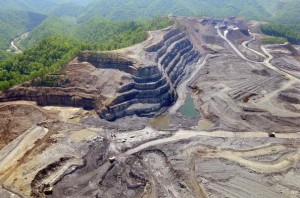According to Mortality Rates in Appalachian Coal Mining Counties: 24 Years Behind the Nation, by Michael Hendryx, of the Department of Community Medicine, West Virginia University, Morgantown, WV <pdf>, mortality is 10.21 % higher in Appalachia than elsewhere in the US, and 18.45 % higher in in coal mining counties where 4 million tons or more of coal are mined. (See also Coal Tattoo.)
Part of the problem is poverty, lack of education, smoking, and other factors, but these are all related to the coal economy.
| Table 1 – Age-Adjusted Mortality per 100,000 for 1999-2004 by County Type | |||
| Appalachian coal-mining
> = 4 million tons |
Appalachian coal mining
< 4 million tons |
Other
Appalachian |
Rest of the nation |
| 950.2 | 890.7 | 884.1 | 802.2 |
| 148 more deaths per 100,000 | 88.5 | 81.9 | |
| 18.45% | 11.03% | 10.21% | |
This “may reflect the unique relationship of mining activity to topography and population centers characteristic of Appalachia. … Coal contains mercury, lead, cadmium, arsenic, manganese, beryllium, chromium, and many other toxic and carcinogenic substances and the mining and preparation of coal at local processing sites releases tons of annual ambient particulate matter and contaminates billions of gallons of water.”
In another study, “with co-author Melissa Ahern of Washington State University, Hendryx reports that the coal industry generates a little more than $8 billion a year in economic benefits for the Appalachian region.
But, Hendryx and Ahern put the value of premature deaths attributable to the mining industry across the Appalachian coalfields at — by one of their most conservative estimates — $42 billion.
“The human cost of the Appalachian coal mining economy outweighs its economic benefits,” they wrote. The costs are 5.25 times higher than the benefits. And that’s only in terms of premature deaths. It doesn’t discuss environmental degradation. <click here>.
Think of it from a whole systems perspective. If coal was so good, why then is Appalachia synonymous with poverty, poor education, and high mortality? As Hendryx writes in the first article,
“Coal mining perpetuates poverty, environmental degregation, economic underdevelopment, and premature death. Coal mining remains an important part of these economies because underdeveloped infrastructure, blasted landscapes, poorly educated workforces, environmental health hazards, and chronically unhealthy populations perpetuate themselves over time and present strong discouragement to new business and population immigration.”
He concludes,
“Coal is mined primarily because there is a national and international market for it, whether or not it benefits the local population. Global initiatives are underway to increase the use of alternative energy sources, and to re-calibrate the price of coal through consideration of environmental costs via carbon taxes or cap-and-trade programs. Such initiatives are critical to mitigate the effects of climate change, and if implemented could dramatically reduce reliance on this polluting energy source. Reductions in the external demand for coal will provide a crisis and an opportunity for the people of Appalachian coalfields to redefine themselves and create healthier environments in a post-carbon world.”
